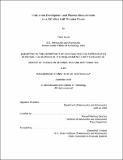| dc.contributor.advisor | Manuel Martinez-Sanchez. | en_US |
| dc.contributor.author | Azziz, Yassir, 1979- | en_US |
| dc.contributor.other | Massachusetts Institute of Technology. Dept. of Aeronautics and Astronautics. | en_US |
| dc.date.accessioned | 2007-07-17T19:41:33Z | |
| dc.date.available | 2007-07-17T19:41:33Z | |
| dc.date.copyright | 2003 | en_US |
| dc.date.issued | 2003 | en_US |
| dc.identifier.uri | http://hdl.handle.net/1721.1/37856 | |
| dc.description | Thesis (S.M.)--Massachusetts Institute of Technology, Dept. of Aeronautics and Astronautics, 2003. | en_US |
| dc.description | This electronic version was submitted by the student author. The certified thesis is available in the Institute Archives and Special Collections. | en_US |
| dc.description | Includes bibliographical references (p. 117-118). | en_US |
| dc.description.abstract | Plume diagnostic instruments were developed and the BHT-200 Hall thruster plume was characterized in order to support ongoing computational plume models. The instruments included a Faraday probe to measure current density, a hot emissive probe to measure plasma potential, and a cold Langmuir probe to measure electron temperature and electron density. Plasma measurements consisted of studying facility and thruster effects on the plume. Facility effects included background pressure and sweep radius, while thruster effects included discharge voltage and flow rate. Experimental results showed that current density is more sensitive to background pressure than to thruster effects, plasma potential is a more direct indicator of plasma density than current flux, and electron temperature and electron density vary substantially across the plume following a polytropic relationship. These experimental results were compared to solutions of a self-similar plume model. Data analyses were also performed using a consistency analysis of the experimental data by deducing plasma potential from Faraday and cold emissive probe data and comparing it to the measured plasma potential from the hot emissive probe. Good agreement was achieved between all experimental data and analysis except in charge exchange dominated regions, since the analyses do not take into account collision effects. Thus, the experimental data obtained can be used to validate computational results. | en_US |
| dc.description.statementofresponsibility | by Yassir Azziz. | en_US |
| dc.format.extent | 142 p. | en_US |
| dc.language.iso | eng | en_US |
| dc.publisher | Massachusetts Institute of Technology | en_US |
| dc.rights | M.I.T. theses are protected by copyright. They may be viewed from this source for any purpose, but reproduction or distribution in any format is prohibited without written permission. See provided URL for inquiries about permission. | en_US |
| dc.rights.uri | http://dspace.mit.edu/handle/1721.1/7582 | |
| dc.subject | Aeronautics and Astronautics. | en_US |
| dc.title | Instrument development and plasma measurements on a 200-watt Hall thruster plume | en_US |
| dc.type | Thesis | en_US |
| dc.description.degree | S.M. | en_US |
| dc.contributor.department | Massachusetts Institute of Technology. Department of Aeronautics and Astronautics | |
| dc.identifier.oclc | 54448230 | en_US |
